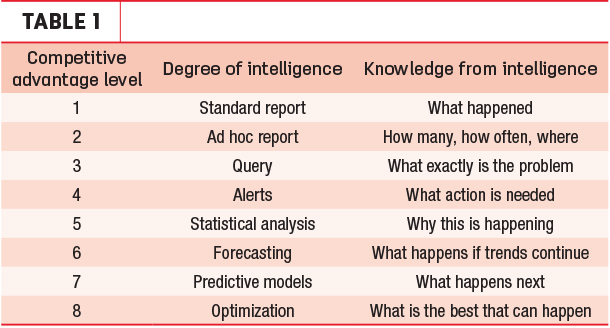The current state of the dairy industry is putting pressure on dairy producers. Excess milk in the market has allowed dairy processors to be more selective with the milk they are purchasing.
Having a low somatic cell count (SCC) no longer guarantees a premium or bonus. Rather, a low SCC is becoming a “cost of doing business.” By using available data, and considering the economics of management decisions, dairy farmers can make better-informed decisions when it comes to managing SCC.
Table 1 was adapted from Competing on Analytics by Thomas H. Davenport and Jeanne G. Harris. This table depicts how businesses can gain a competitive advantage by improving business intelligence through better use of data.

The more data or information used to make a decision, the higher the level of competitive advantage and the more informed decisions will be. For example, with the most standard reports, only what happened is collected (i.e., this cow has a case of mastitis).
Analytical businesses use optimization models to determine what is the best outcome in a situation. Right now, most of the dairy industry stops just one step above simple reports at ad hoc reports (level 2). When examining mastitis cases in an ad hoc report, the number of cases and cow ID are often the only data collected. By collecting just a little more data, a better-informed decision can be made.
With a mastitis case, a bacteriological culture identifies the causative pathogen, providing more data to improve treatment or prevention decisions. Additionally, the costs and benefits of the management decision need to be considered. No matter what is done to manage SCC, an indicator of subclinical mastitis, there will always be a cost associated with subclinical mastitis.
The cost of managing subclinical mastitis (or any disease) can be broken down into a simple equation: C = L + E, where C is the cost of elevated SCC, L is benefits that are taken away (lost milk production or discarded milk from treatment of mastitis), and E is the expenditures associated with SCC.
If no management strategies are employed to manage SCC, maximum losses will occur. On the other hand, too much can be spent on management practices. If you spend $1 to manage SCC and only receive 95 cents back, the economics of this decision are not justified.
When it comes to making the right economic decision, most problems are too complicated for the human mind to figure out promptly. So how is the best-informed decision made? Decision support tools, or dashboards, which are computer-generated models using herd-specific data, can help aid in a better-educated decision. These decision support tools are currently available from the University of Kentucky:
- The SCC Economic Opportunity Dashboard allows dairy farmers to calculate an economic benefit from reaching a goal SCC. By calculating current pay and bonus structure for SCC, current daily milk yield, and current and goal SCC, the dashboard calculates losses from milk yield and missed premiums due to elevated SCC.
- The Hotsheet Dashboard allows producers on DHIA test to make better sense of their Hotsheet data. A Hotsheet is a report given to producers on-test which lists cows that contribute the most to the bulk tank SCC. By providing milk shipped per day, current pricing and bonus structure, and information from the Hotsheet, the decision support tool calculates an economic opportunity from discarding milk from high-SCC cows from the bulk tank.
After all the data is entered into the dashboard, the farmer can choose which combination of cows they would like to discard to achieve the most economical outcome. The Hotsheet Dashboard is most useful for smaller producers where a small number of cows can have a significant impact on bulk tank SCC.
- The decision-making process for clinical mastitis treatment is complex. If cow demographics (lactation, days in milk, cull value) and bacteria type are considered, many variables can impact whether that treatment will be successful.
The Mastitis Treatment Dashboard allows the dairy farmer to make a step-by-step decision to find an optimal mastitis treatment decision. After inputting specific cow and market information, the user follows a decision tree of mastitis treatment options. In a results page, a review of the selected treatment choice is displayed along with the probability of cure from that choice.
A total breakdown of the costs associated with that case of mastitis is also displayed to better inform producers of the cost of mastitis.
Decisions support tools are just one way to aid dairy farmers in increasing their level of competitive advantage. Now instead of being at level two and stopping at ad hoc reports, data collected from the ad hoc reports can be used in forecasting or even optimization at the greatest levels of competitive advantage.
For example, the use of the Mastitis Treatment Dashboard allows dairy farmers to input ad hoc data to determine an optimal mastitis treatment regimen.
As the use of technology grows on dairy farms, farmers can become more competitive and efficient. The use of the data provided will allow producers to make better informed decisions that lead to a more desirable outcome.
To access the decision support tools discussed in this article and many more made available by the University of Kentucky, visit online (Decision Tools). ![]()
Derek Nolan is a graduate research assistant at the University of Kentucky studying the economics of mastitis. Jeffrey Bewley is a former dairy professor at the University of Kentucky and now a support manager with BoviSync.





